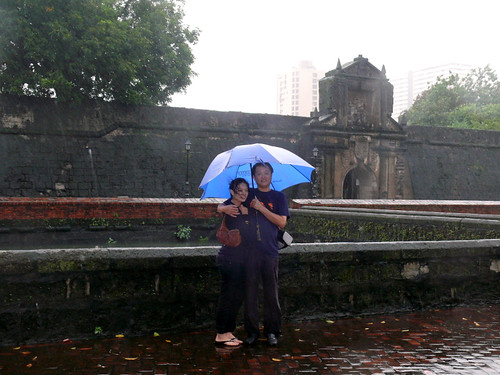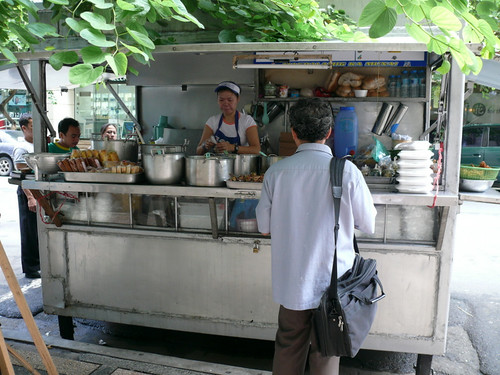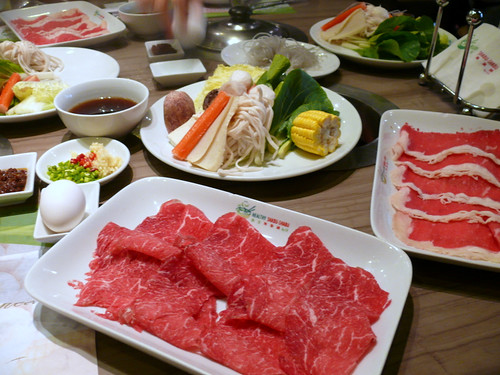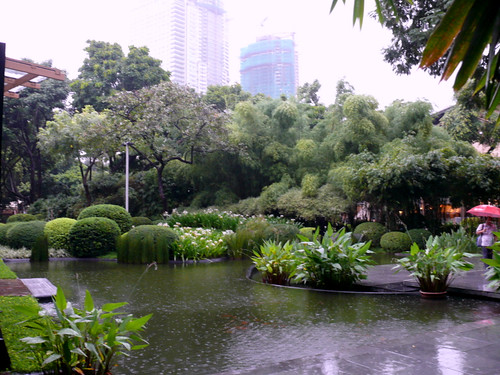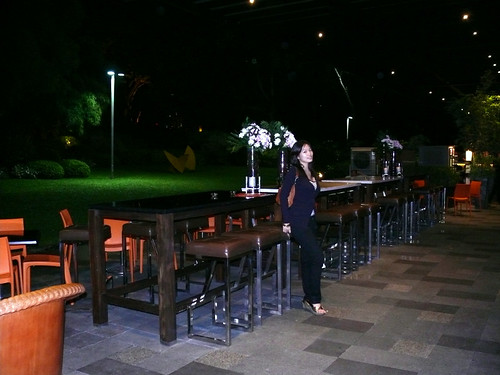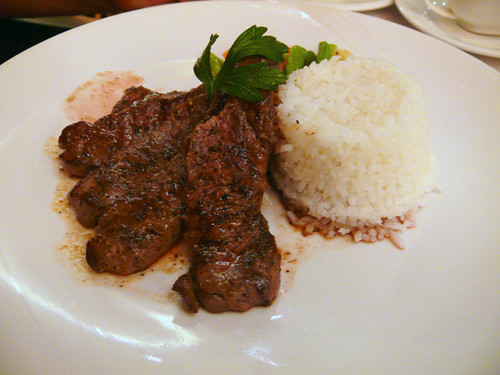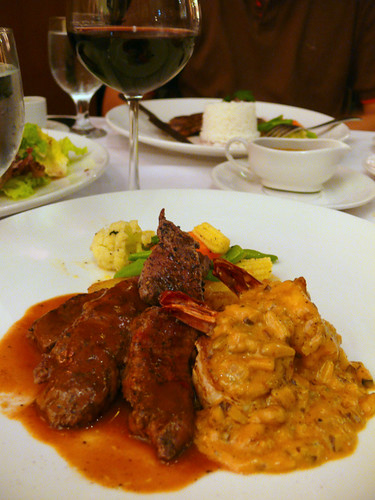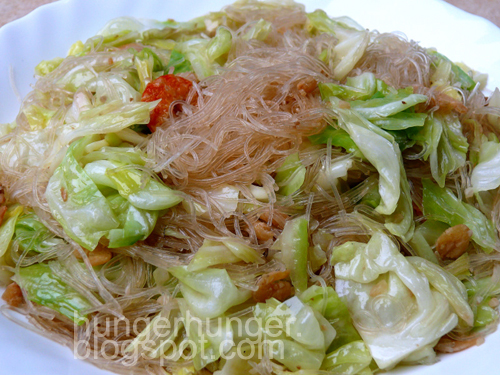
Stir-fried cabbage, dried shrimps and mung bean noodles
The only veg left in my fridge was a cabbage. Ah ha. Ran to the nearest grocers and got some mung beans (the beans that grow into bean sprouts) noodles or vermicelli or glass noodles as they call it here. Dug out that bag of dried shrimps. Why is it that the thing I want is always at the bottom of the chiller compartment? Grabbed that container of chopped garlic (thank God for Vero, who makes sure there's always chopped garlic). Everything into the wok, and out came this dish which is commonly served in economy buffet lunches. Sometimes I am surprised by how a 'lowly' dish can be so tasty. The cabbage is sweet and crunchy. There's the fragrance of fried garlic and dried shrimps and the vermicelli is soft and saturated with the flavors of the dried shrimps and garlic. A sprinkle of chili-lime sauce, and I can't stop eating until it's half gone.
I told you. It's no-sweat cooking in my kitchen this week. Nothing creative, just plain old-fashioned dishes that some of you may have forgotten to cook in a long time. Now excuse me while I rush to watch The Little Nyonya, the only TV series from Singapore's Mediacorp that doesn't make me cringe. And best of all, Fan Wong's not in it. I don't have to watch her only two expressions--lips slightly parted and looking blank, indicating surprise or confusion or unhappiness or dejection or sadness (depending on the circumstances, you figure) and lips widely parted, indicating happiness. Six (or more) emotions, two looks.
Cabbage Bean Noodles N Dried Shrimps Stir Fry
1 small cabbage
200 g dried mung bean noodles (fen se/glass noodles/tang hoon)
1/3 cup dried shrimps
1 T chopped garlic
3 T veg oil
1/4 t salt
2-4 t light soy sauce
1 cup water from soaking the shrimps
1/2 t chicken powder
Prep: The proportion of cabbage to the noodles is up to you. We usually prefer more noodles to veg. Cut the cabbage into 2 cm slices. Wash the dried shrimps and soak them in 1 cup of water until softened. Remove the dried shrimps and keep the water. Soak the glass noodles in room temp water for 5 minutes, drain.
1. Heat up the wok, add the oil and throw in the dried shrimps. Stir continuously over medium fire until the shrimps start to turn crispy. Add the garlic and continue to stir fry.
2. When the garlic begins to turn golden, add the cabbage and the salt. Stir, add 1/2 cup of the shrimp water and cover the wok.
3. After 1 minute, remove the cover, stir fry to move the bottom ingredients up, cover and let it cook for about 1/2 minute to 1 minute. Remove the cover, increase the heat and if you like the cabbage crispy and not overcooked, add the noodles and the remaining ingredients including the water now. Cook another minute or more if you like the cabbage softer. If you like more color, add more soy sauce. Taste and season accordingly. Do not cook the noodles for too long or they will start to break up. Add one or two spoonsful of water if the noodles look dry.
The only veg left in my fridge was a cabbage. Ah ha. Ran to the nearest grocers and got some mung beans (the beans that grow into bean sprouts) noodles or vermicelli or glass noodles as they call it here. Dug out that bag of dried shrimps. Why is it that the thing I want is always at the bottom of the chiller compartment? Grabbed that container of chopped garlic (thank God for Vero, who makes sure there's always chopped garlic). Everything into the wok, and out came this dish which is commonly served in economy buffet lunches. Sometimes I am surprised by how a 'lowly' dish can be so tasty. The cabbage is sweet and crunchy. There's the fragrance of fried garlic and dried shrimps and the vermicelli is soft and saturated with the flavors of the dried shrimps and garlic. A sprinkle of chili-lime sauce, and I can't stop eating until it's half gone.
I told you. It's no-sweat cooking in my kitchen this week. Nothing creative, just plain old-fashioned dishes that some of you may have forgotten to cook in a long time. Now excuse me while I rush to watch The Little Nyonya, the only TV series from Singapore's Mediacorp that doesn't make me cringe. And best of all, Fan Wong's not in it. I don't have to watch her only two expressions--lips slightly parted and looking blank, indicating surprise or confusion or unhappiness or dejection or sadness (depending on the circumstances, you figure) and lips widely parted, indicating happiness. Six (or more) emotions, two looks.
Cabbage Bean Noodles N Dried Shrimps Stir Fry
1 small cabbage
200 g dried mung bean noodles (fen se/glass noodles/tang hoon)
1/3 cup dried shrimps
1 T chopped garlic
3 T veg oil
1/4 t salt
2-4 t light soy sauce
1 cup water from soaking the shrimps
1/2 t chicken powder
Prep: The proportion of cabbage to the noodles is up to you. We usually prefer more noodles to veg. Cut the cabbage into 2 cm slices. Wash the dried shrimps and soak them in 1 cup of water until softened. Remove the dried shrimps and keep the water. Soak the glass noodles in room temp water for 5 minutes, drain.
1. Heat up the wok, add the oil and throw in the dried shrimps. Stir continuously over medium fire until the shrimps start to turn crispy. Add the garlic and continue to stir fry.
2. When the garlic begins to turn golden, add the cabbage and the salt. Stir, add 1/2 cup of the shrimp water and cover the wok.
3. After 1 minute, remove the cover, stir fry to move the bottom ingredients up, cover and let it cook for about 1/2 minute to 1 minute. Remove the cover, increase the heat and if you like the cabbage crispy and not overcooked, add the noodles and the remaining ingredients including the water now. Cook another minute or more if you like the cabbage softer. If you like more color, add more soy sauce. Taste and season accordingly. Do not cook the noodles for too long or they will start to break up. Add one or two spoonsful of water if the noodles look dry.






